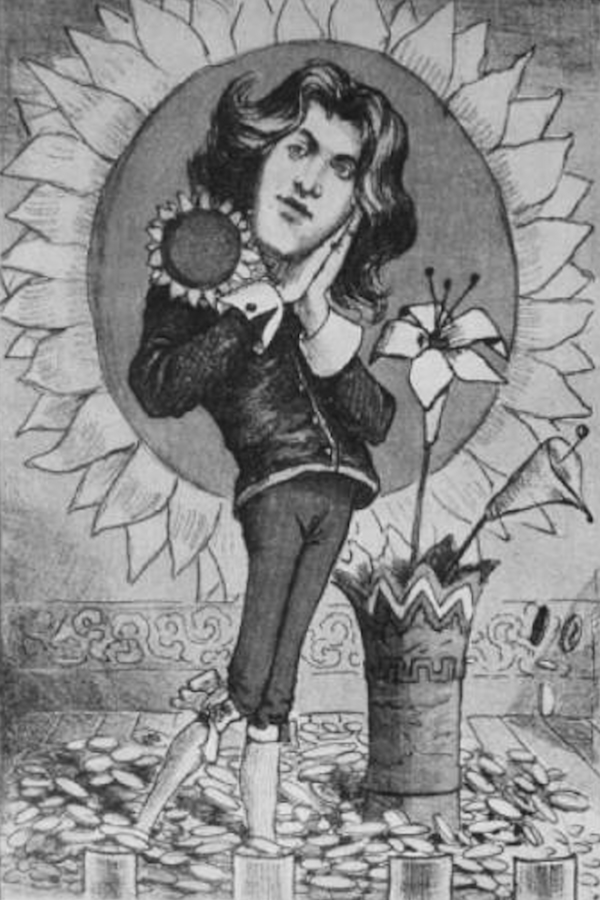
“Chinese art possess no elements of beauty.”
Oscar Wilde offered up that curious opinion on a San Francisco-bound ferry boat to a crowd of reporters anxious to record his first impression of the city, which at the time supported one of largest communities of Chinese outside the so-called Celestial Empire. Wilde had been in the United States since January, lecturing the colonials on interior decoration, art, design, and an obscure subject he called “The English Renaissance,” ahead of the Gilbert & Sullivan light opera, “Patience.” On this sunny morning in March, 1882, the Irish aesthete had wended his way across the continent to “the Occidental uttermost of American civilization,” making a sensation along the way in big cities and mining camps alike.
Wilde had been averse to things Chinese since boyhood, when he heard a Chinese “fiddle” at an exhibition in Paris. “I could discern no music in it,” he told the reporters. While Wilde had seen “much that was admirable” in the arts of Japan, whose blue vases and delicately painted fans were all the rage of the Aesthetic Movement back in London, he found in Chinese art that only “the horrible and grotesque” appeared “to be standards of perfection.”
Wilde had ventured his comments after asking a reporter to point out where the city’s Chinese settlement lay on the hilly grid of streets then visible from San Francisco Bay. He had tasted, indeed drunk deeply, the exotic flavor of frontier life in the American West. Now he was considering going further. Behind the slip of land upon which rested the roaring boomtown-cum-metropolis of San Francisco lay the Pacific. And beyond that, Asia. Perhaps he would visit Japan, home to those charming vases and airy prints that he so admired.
The Westerners had treated Wilde kindly, taking in stride his eccentricities of dress and his long hair. Back East, where, he thought, men had devolved into shorn and respectable drones, they had ridiculed him. But out West things were different. Cowboys, miners, even honored gentlemen, endeared to the kind of Indian brave-style flamboyance that inspired icons like Buffalo Bill Cody, often wore their hair shoulder length like proud cavaliers (an analogy Wilde himself made in letters back home). Not that the press in the West had been much kinder to the aesthete than it had in the East. Reporters everywhere rejoiced in lambasting the “greenery, yallery” fop by making endless sport of his “womanish” talk and extravagant mannerisms. Caustic columnist for The Wasp and famed curmudgeon, Ambrose Bierce, nearly flayed the aesthete alive in print. But, press aside, freedom was what Wilde felt on the American frontier. And San Francisco, though still a city barely teething, was already used to eccentrics. Hell, they ran the town.
But life for the city’s Chinese immigrants was rough in those days, even without the 28-year-old “sunflower man” as the Chinese called him — and his cultural criticism. Between the building of the Transcontinental Railroad and Wilde’s visit, some 75,000 Chinese had come to “Gold Mountain,” as they called California, looking for a better life. Instead what they found were paranoid white settlers who reacted with legal injunctions, legislative restrictions, and mob violence. The populist politico, Dennis Kearney, epitomized the reaction. Like some kind of low-rent, latter-day Cato, Kearny urged his mobs to the edge of violence with speeches that always ended in the refrain “The Chinese must go!”
Wilde’s first impressions of the city were not good. From the ferry terminal he was taken by carriage down Market Street to his lodgings at William Ralston’s Palace Hotel, then reputed to be the largest hotel in the world. Wilde was stunned by the sheer vulgarity of it all. “Dreary. Utterly inexpressively hideous,” he said of San Francisco’s houses, suggesting that the city’s now storybook Victorians were not as gaily painted then as they are today. (Wilde was not alone. Built in lots by real estate developers, just as new homes are today, the city’s gingerbread houses were thought by some at the time to be little more than overstated tract houses built of cheap “stick”). When Wilde did express a positive impression of America, it rarely went reported in the press, although the San Francisco Chronicle reported his appreciation of Mt. Tamalpais. “How utterly lovely!” he was quoted as saying.
Shuttled from one train station to another, one hotel to another, one lecture hall to another, Wilde rarely had time to come to know a place with any intimacy. But he had almost three weeks to kill in San Francisco. His first San Francisco lecture was scheduled to take place in Platt’s Hall on Montgomery Street on March 27, 1882. Though the notices were mixed, the hall was filled and would remain so for subsequent lectures. (In fact, matinee performances were added to the itinerary to placate culture-hungry San Franciscans.)
Before his second lecture, Wilde visited “China Town.” He was intrigued enough to return the next night. After his evening lecture and a brief tour of the San Francisco Chronicle‘s offices, he returned with an escort to take him through the district’s nighttime underworld. He was taken through shops, restaurants, theaters, “joss houses” (Chinese shrines), hospitals, and opium dens. “I found them drinking tea out of china cups as delicate as the petals of a rose leaf,” he wrote. Meanwhile, at the “gaudy” Palace Hotel, he complained to a reporter, he was forced to work through his teatimes hefting a delft cup “an inch thick” and so heavy it seemed to be intended as a weapon. Later, in his memoir of his American tour, he increased the cup’s thickness by another half-inch.
Wilde acknowledged the poverty of the place while admiring its beauty. “This is not an expensive place for wealthy people,” he said. “It was for the common people. The laborers on the railroad came here.” Though poor, the “strange, melancholy Orientals,” Wilde decided, “have determined that they will have nothing about them that is not beautiful.” The aesthetic creed that Wilde followed, nascent in Pre-Raphaelite philosophy and coming full blown in the Aesthetic Movement, dictated that it was the responsibility of craftsmen to make beautiful everything they made, and that it was the duty of people of all classes was to refine their sensibilities in order to appreciate them. Amid the epic, Dickensian squalor of San Francisco’s Chinatown, he found what he was looking for.
Nine days after his Chinatown adventure, Wilde was invited to a party at 728 Montgomery St., the studio of San Francisco artist, Jules Tavernier (and later the offices of flamboyant attorney Melvin Belli, “King of Torts“). In her memoir, Isobel Field, one of Tavernier’s circle, wrote, “This was the most successful party we ever gave.” Sing Lee, from Chinatown, was also invited. Dressed in a traditional gown of silk brocade and with his long queue braided with strands of scarlet silk falling out from under his Mandarin cap, Lee made tea for Wilde and the other guests. The skylight of the studio was painted with fanciful flowers and vines for the event. “This is where I belong!” Wilde is said to have exclaimed as he swept into the studio and beheld Lee, the elegant tea things, the painted skylight and the bohemian company. “I didn’t know such a place existed in the whole US.”
Wilde was cured of his anti-Chinese prejudice. For the rest of his American journey (he never made it to the Orient), he defended the Chinese and held up the Celstials, and what he considered their refined aesthetic sensibilities, as a model for others to aspire to. Perhaps, owing to the ill treatment he had received from the American press, he felt a little of their persecution. Wilde made his case through the medium he knew best: criticism, whose most important elements, wit and charm, he had in abundance.
“San Francisco really is a beautiful city,” he would write in his American memoir. “And China Town, peopled by Chinese laborers, is the most artistic town I have ever come across.” — MICHAEL MATTIS

A nice look into Wilde’s American adventure in San Francisco. Puts me in mind of an early statement of Wilde when he was still a student at Oxford, “How often I feel how hard it is to live up to my blue china.”
Thank you for an interesting read and historic look at San Francisco. I knew he visited, but did not know any details. One wonders what he would thin of our little town now.
One also wonders what he would THINK of San Francisco now.
Damn this keyboard
A very fine piece of work Michael. You did the subject much justice.
Michael:
You, sir, are a dandy national treasure.
“Caustic, Wasp writer”
Haha. Had me chuckling there.
Ah. “The Wasp” was a publication that Bierce wrote for. I should have noted that.
I love that Oscar was so able to be persuaded by beauty, and to abandon a prejudice once he had been shown how wrong he was. That takes an extraordinarily strong psyche to do that.
Very well written article, about something I hadn’t ever pieced together about Oscar’s attitude to the Chinese culture.
I have just come across with your blog and I am already in love. I am going to add you to my blogroll. All the best, darling!
You’ve got an incredible blog. I don’t think I’ve ever been here before, but I definitely really like it.